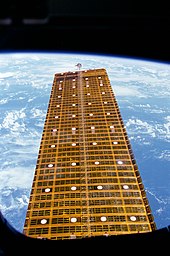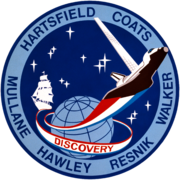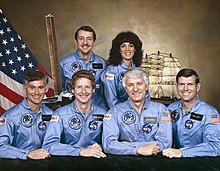 The experimental OAST-1 solar array in flight | |
| Names | Space Transportation System-12 |
|---|---|
| Mission type | Satellites deployment |
| Operator | NASA |
| COSPAR ID | 1984-093A |
| SATCAT no. | 15234 |
| Mission duration | 6 days, 56 minutes, 4 seconds |
| Distance travelled | 4,010,000 km (2,490,000 mi) |
| Orbits completed | 97 |
| Spacecraft properties | |
| Spacecraft | Space Shuttle Discovery |
| Launch mass | 119,511 kg (263,477 lb) |
| Landing mass | 91,418 kg (201,542 lb) |
| Payload mass | 18,681 kg (41,185 lb) |
| Crew | |
| Crew size | 6 |
| Members | |
| Start of mission | |
| Launch date | August 30, 1984, 12:41:50 UTC (8:41:50 am EDT) |
| Launch site | Kennedy, LC-39A |
| Contractor | Rockwell International |
| End of mission | |
| Landing date | September 5, 1984, 13:37:54 UTC (6:37:54 am PDT) |
| Landing site | Edwards, Runway 17 |
| Orbital parameters | |
| Reference system | Geocentric orbit[1] |
| Regime | Low Earth orbit |
| Perigee altitude | 346 km (215 mi) |
| Apogee altitude | 354 km (220 mi) |
| Inclination | 28.50° |
| Period | 90.60 minutes |
| Instruments | |
| Continuous Flow Electrophoresis System (CFES) | |
 STS-41-D mission patch  Back row: Walker and Resnik Front row: Mullane, Hawley, Hartsfield and Coats | |
STS-41-D (formerly STS-14) was the 12th flight of NASA's Space Shuttle program, and the first mission of Space Shuttle Discovery. It was launched from Kennedy Space Center, Florida, on August 30, 1984, and landed at Edwards Air Force Base, California, on September 5, 1984. Three commercial communications satellites were deployed into orbit during the six-day mission, and a number of scientific experiments were conducted, including a prototype extendable solar array that would eventually form the basis of the main solar arrays on the International Space Station (ISS).
The mission was delayed by more than two months from its original planned launch date, having experienced the Space Shuttle program's first launch abort at T-6 seconds on June 26, 1984.